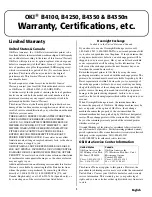
6
Material Safety Data Sheet
Type 9 Toner P/N 42103001 & 42102901
MSDS #58356601
For more information, contact Oki Data at:
2000 Bishops Gate Boulevard
Mount Laurel, NJ 08054-4620
Emergency Information:
call 1-800-OKI-DATA (1-800-654-3282); US & Canada Only
Emergency First Aid Procedures
Toner swallowed (ingested).
Immediately seek medical attention. Never give anything by
mouth to an unconscious person. If possible, rinse out mouth
and give one or two glasses of water or milk to drink.
Toner inhaled.
Remove person to fresh air. Seek medical attention.
Toner gets in the eyes.
Flush eyes with large quantities of cool water for 15 minutes,
keeping the eyelids open with fingers. If necessary, seek medical
attention.
Toner gets on the skin.
Wash toner off the skin with plenty of cool water and soap. If
necessary, seek medical attention.
Hazardous Ingredients
Chemicals:
Styrene-Butyl Acrylate Copolymer (84% by weight)
CAS# 25767-47-9
OSHA TWA 15 mg/m
3
for total dust
ACGIH TLV 10 mg/m
3
for total dust
Carbon Black (5-7% by weight)
CAS# 1333-86-4
OSHA TWA 3.5 mg/m
3
ACGIH TLV 3.5 mg/m
3
Fatty acid ester (5-10% by weight)
CAS# 61682-73-3
OSHA TWA --
ACGIH TLV --
Additives (1 to 3% by weight)
CAS# 67762-90-7
OSHA TWA 15.0 mg/m3 for total dust
ACGIH TLV 10.0 mg/m3 for total dust
Carcinogens:
Carbon Black
IARC - 2B
Physical /Chemical Characteristics
Melting Point:
110°C (230°F)
Boiling Point (Softening Point):
Not applicable
Vapor Pressure mmHg:
Not applicable
Vapor Density (Air=1):
Not applicable
Evaporation Rate:
Not applicable
Specific Gravity (H
2
O=1):
1.15
Solubility in water:
Negligible
Appearance and odor:
Black Powder, Odorless
Fire and Explosion Hazard Data
Flash Point (Method Used):
Not applicable
Flammable Limits
Lower Explosive Limit:
Not applicable
Upper Explosive Limit:
Not applicable
Explosion Limits
Lower Explosive Limit:
60g/m
3
Upper Explosive Limit:
Unknown
Extinguishing Media:
Water, CO
2
, ABC Dry Chemical, or
Protein type air foams.
Special Fire Fighting Procedures:
Do not use methods that
may create a dust cloud, such as high pressure water and/or
steam.
Unusual Fire and Explosion Hazards:
Thermal decomposition of organic components may result
in release of oxides of carbon and nitrogen.
Reactivity Data
Stability:
Stable
Condition to Avoid:
Do not expose to temperature above
200°C.
Incompatibility (Materials to Avoid):
Avoid exposure to
strong oxidizers.
Hazardous Polymerization:
Will not occur.
Condition to Avoid:
None.
Hazardous Decomposition Products:
Carbon Oxide.
Health Hazard Data
Routes of Entry:
Inhalation, Ingestion, Eyes, Skin.
Eye Contact:
Eye irritation will be caused. If contacted, flush
eyes with running water for several minutes with eyelids
open. Consult an eye doctor.
Skin Contact:
No symptoms will appear. If contacted, remove
contaminated clothes and wash skin with soap and water.
Inhalation:
Lung irritation, difficult breathing, sneezing,
coughing, will be caused. If inhaled, remove the sufferer to
fresh air and call a physician.
Ingestion:
Stomach irritation will be caused. If ingested, call a
physician.
Health Hazards (Acute and Chronic)
Acute Oral Toxicity: LD50>2000mg/Kg(Rat)
Ames Test: Negative
Acute Inhalation Toxicity: LC50>4.98mg/l/(Rat)
Skin Irritation: No irritant (Rabbit)
Eye Irritation: Minimal irritant (Rabbit)
Carcinorgenicity: NTP; NL IARC Monograph;
NL OSHA Regulated; NL NL: Not Listed
Note
Small amounts of toner on skin or clothing can easily be
removed with soap and cold water. Hot water makes toner
harder to remove.
English







































